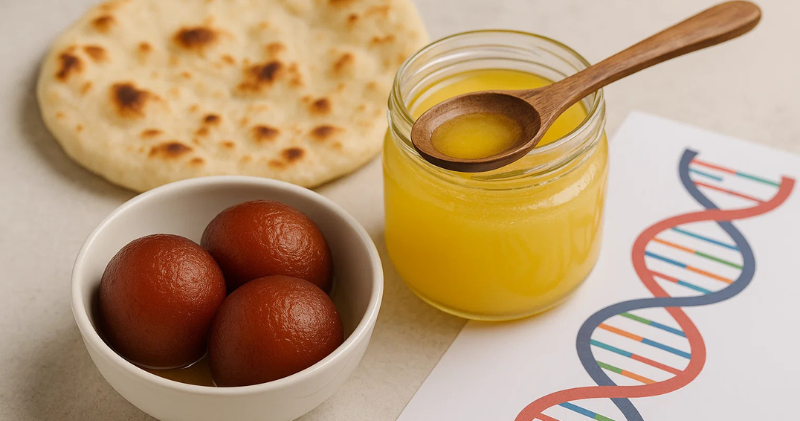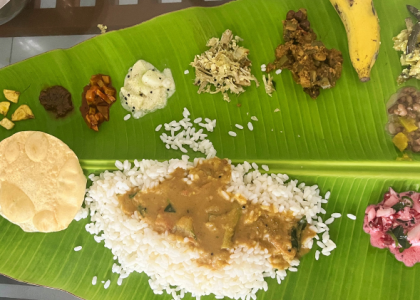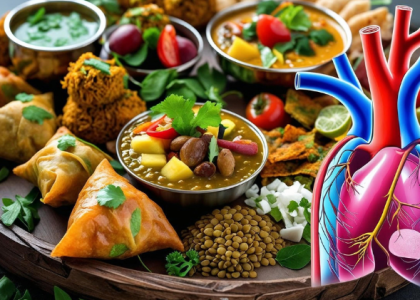Picture the scene: a wedding reception where your plate overflows with fragrant biryani, golden gulab jamuns glistening in syrup, and steaming parathas dripping with ghee. Your proud uncle pats his belly and declares, “This is what kept our ancestors strong for thousands of years!” The aunties nod approvingly as they pile more sweets onto your already groaning plate.
But here’s the uncomfortable truth hiding behind this beautiful cultural moment: many of those same uncles and aunties are quietly suffering heart attacks in their 40s and 50s. Despite our rich traditions of spices, vegetables, and ancient wisdom, South Asians living worldwide have some of the highest rates of heart disease on the planet.
How did the cuisine that sustained generations become a threat to our hearts? The answer lies in a perfect storm of dietary changes, cultural behaviors, and genetic predispositions that our ancestors never had to navigate. The good news? Understanding this triple threat means we can finally break the cycle—without abandoning our heritage.
The Sweet Problem: When Sugar Becomes the Silent Killer
Walk into any South Asian household during festival season, and you’ll find enough sugar to power a small city. From the daily chai loaded with sugar and condensed milk to the endless parade of mithai (sweets) that mark every celebration, our relationship with sugar runs deeper than taste—it’s woven into our expressions of love and hospitality.
But our bodies weren’t designed for this constant sugar assault. Traditional gulab jamuns, rasmalai, and jalebi were once rare treats reserved for special occasions. Today, many families consume sweets multiple times per week, often paired with refined carbohydrates like white rice and refined wheat.
Every time we eat these foods, our blood sugar spikes dramatically. According to research published in The Lancet, South Asians experience higher post-meal glucose levels than other populations, even when eating the same foods¹. This creates a cascade of problems: elevated triglycerides, insulin resistance, and the accumulation of dangerous belly fat—even in people who look thin.
The vegetarian advantage that our grandparents enjoyed has been hijacked by processed foods and added sugars. A typical “healthy” South Asian meal today might include white rice, dal with added sugar, sweet lassi, and a small gulab jamun for dessert. That’s more sugar in one meal than our ancestors consumed in a week.
This constant glucose rollercoaster doesn’t just affect diabetics—it’s damaging the arteries of seemingly healthy South Asians for years before any symptoms appear. The traditional sweets we use to show love might literally be breaking our hearts.
Ghee, Oils & the Great Fat Confusion
Let’s address the elephant in the room: ghee. For generations, this golden clarified butter has been revered in Ayurveda as a healing food. Your grandmother probably swears it cured everything from dry skin to digestive issues. But somewhere between ancient wisdom and modern reality, things got complicated.
The problem isn’t ghee itself—it’s how we use it today. Traditional ghee consumption was minimal and balanced with intense physical activity. Modern usage often involves liberal amounts on everything from rotis to rice, combined with sedentary lifestyles that can’t process the extra calories.
But ghee isn’t the biggest villain in our kitchens. The real damage comes from reused cooking oils in restaurants and street food, processed snacks, and the sheer volume of fried foods now common in South Asian diets. That crispy samosa or pakora you grab from the local shop? It’s likely been fried in oil that’s been reheated multiple times, creating harmful compounds that damage blood vessels.
The British Heart Foundation notes that South Asian cooking methods—particularly deep frying and oil-heavy curries—can turn otherwise healthy vegetables into calorie bombs². A single serving of restaurant-style palak paneer can contain more calories than a burger, mostly from oil and cream that traditional recipes never included.
The confusion deepens when Western nutritional advice conflicts with Ayurvedic principles. Should you follow your doctor’s low-fat diet or your grandmother’s ghee wisdom? The answer lies in understanding quality, quantity, and context—something both approaches often miss.
Genetic Roulette: The Desi Body Type
Here’s where the story gets really interesting—and a bit unfair. South Asian bodies are fundamentally different from the European bodies that most medical research has focused on. We’re playing genetic roulette with a deck that’s stacked against us.
Scientists call it the “thrifty gene” theory: our ancestors survived centuries of famines by developing bodies that efficiently store fat and conserve energy. These genetic adaptations were lifesavers during food shortages but become liabilities in a world of abundant refined carbohydrates and desk jobs.
Research published in the INTERHEART Study shows that South Asians develop heart disease 5-10 years earlier than Caucasians, often with lower BMIs and seemingly normal cholesterol levels³. We’re more likely to store fat around our organs (visceral fat) rather than under our skin, making us look deceptively healthy while our internal organs struggle.
Our baseline insulin resistance is higher, our HDL (good) cholesterol tends to be lower, and we’re more likely to have elevated levels of dangerous particles like Lp(a) and ApoB—even when standard cholesterol tests look normal. It’s like having a sports car engine that needs premium fuel but running it on regular gas for decades.
The Harvard School of Public Health found that South Asians can develop diabetes at BMIs as low as 22-23, compared to 27-30 for other populations⁴. Your “skinny” cousin who never exercises but stays thin? They might have the metabolic profile of someone much heavier from another ethnic background.
It's Not Just the Genes—Lifestyle Pulls the Trigger
Genetics load the gun, but lifestyle pulls the trigger. And unfortunately, modern South Asian lifestyle patterns create the perfect storm for heart disease.
Cultural patterns that once made sense now work against us. Late dinners followed immediately by sleep (common when families gather after long work days) interfere with metabolism and fat burning. The cultural emphasis on academic and career achievement often comes at the expense of physical activity and stress management.
Gender roles add another layer of complexity. South Asian men often gain weight early in their careers, especially around the belly, while women may remain thin but metabolically unhealthy due to limited physical activity and family caregiving stress. Women’s heart disease is frequently underdiagnosed because it doesn’t match the “typical” presentation doctors learn about.
The sedentary migration pattern affects entire families. Grandparents who walked miles daily in India now live in suburbs where driving is necessary for everything. Children who played outside all day now spend hours on screens. The same families, but completely different energy expenditure.
Work stress, family expectations, and the pressure to succeed in new countries create chronic cortisol elevation—a hormone that promotes belly fat storage and insulin resistance. The “model minority” stereotype might be slowly killing us through perfectionist stress.
What You Can Do—Without Giving Up Everything
The solution isn’t to abandon your culture or never eat gulab jamun again. It’s about making strategic shifts that honor tradition while protecting your health.
Smart Swaps That Don’t Feel Like Punishment:
- Replace daily sugary chai with spiced herbal teas (ginger, cardamom, cinnamon)
- Reserve sweets for weekends and festivals, not daily treats
- Use traditional spices like turmeric, fenugreek, and cinnamon—they’re natural blood sugar stabilizers
- Practice portion control: enjoy the foods you love, just not in restaurant-sized servings
Movement That Fits Your Life:
- Count household chores as exercise—vigorous cleaning burns calories
- Take phone calls while walking, especially for long family conversations
- Use stairs whenever possible, park farther away
- Dance to Bollywood music for 20 minutes—it counts as cardio
Testing That Could Save Your Life: Skip the basic “everything looks normal” checkup. Ask for:
- ApoB levels (more accurate than standard cholesterol)
- HbA1c (shows blood sugar control over months)
- Triglycerides (often elevated in South Asians)
- Waist-to-hip ratio (better than BMI for our body types)
Family Conversations, Not Shame: Share this information with loved ones, but lead with curiosity, not judgment. “I learned something interesting about our health” goes further than “you need to stop eating sweets.”
Culture Can Be Healing Too
Before you despair about your genetic hand or feel guilty about every bite of biryani, remember this: the same culture that created modern health challenges also holds ancient wisdom for healing.
Traditional South Asian diets were plant-rich, spice-heavy, and naturally anti-inflammatory. Our ancestors ate seasonally, fasted regularly, and moved constantly. They used food as medicine, understanding that turmeric reduces inflammation, bitter gourd helps blood sugar, and ginger aids digestion.
The problem isn’t our heritage—it’s how we’ve modernized it. By reclaiming the healthy aspects of traditional eating while adapting to modern realities, we can turn culture from a liability into an asset.
Your genes might have loaded the gun, but you get to choose whether lifestyle pulls the trigger. Every meal is a chance to honor your ancestors’ wisdom while protecting your children’s future. Every step you take, every stressful moment you manage differently, every conscious food choice tips the scales back in your favor.
The story doesn’t have to end with uncles having heart attacks at 45 or aunties developing diabetes at 50. You can write a different ending—one where culture and health work together, not against each other.
Start today. Your heart—and your family’s future—will thank you.
Ready to take action?
- Download our “Desi Heart Numbers Cheat Sheet” for the specific tests every South Asian should request
- Take our Heart Risk Quiz to get your personalized assessment in 2 minute
- Share this with your family WhatsApp group – knowledge saves lives when it’s shared
References:
The Lancet – Cardiovascular disease and diabetes in South Asians: https://www.thelancet.com/journals/lancet/article/PIIS0140-6736(04)16265-3/fulltext
British Heart Foundation – South Asian cardiovascular disease: https://www.bhf.org.uk/informationsupport/publications/statistics/south-asian-factsheet
INTERHEART Study – Risk factors for acute myocardial infarction in South Asians: https://www.ahajournals.org/doi/10.1161/CIRCULATIONAHA.107.705370
Harvard School of Public Health – Ethnic differences in BMI and disease risk: https://www.hsph.harvard.edu/obesity-prevention-source/ethnic-differences-in-disease-risk/
World Health Organization – Diabetes country profiles 2016: https://www.who.int/diabetes/country-profiles/diabetes_profiles_ind.pdf




